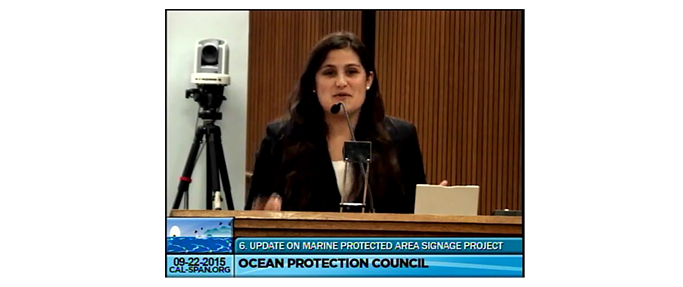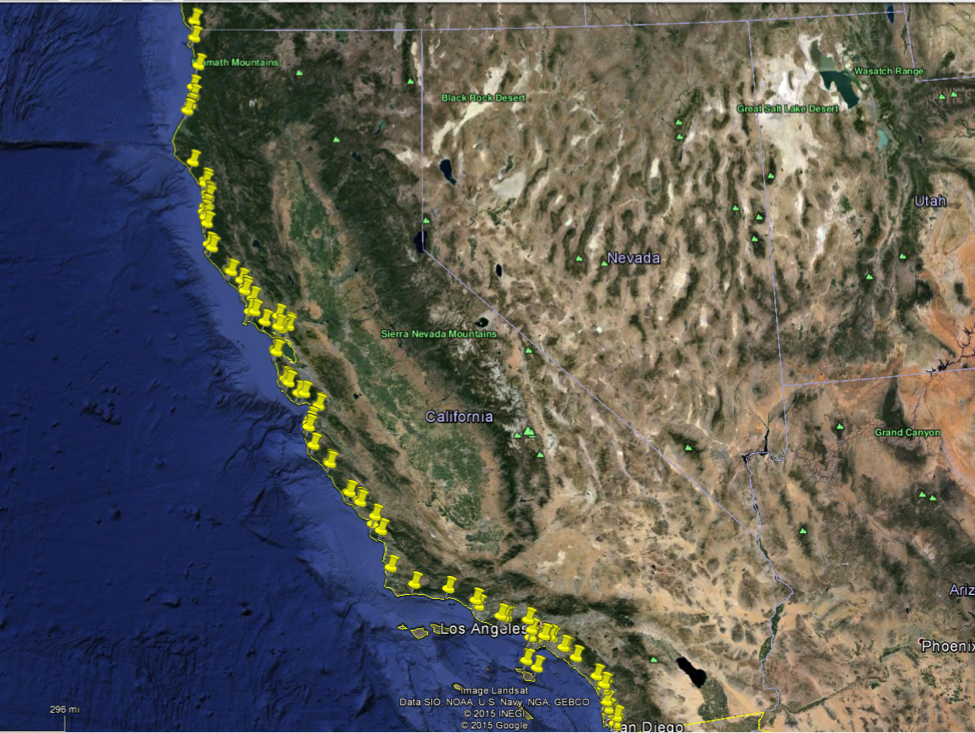When I first learned I would be working for the Ocean Protection Council (OPC) as a Sea Grant Fellow, I saw myself sitting in on important policy conversations and helping to craft documents that would shape how the state manages ocean resources for decades to come. I even contemplated presenting to the Council and getting my 5-minutes of webcasted-hearing fame. What I didn’t imagine was that when that 5 minutes came, it would be about something as tangible (and even prosaic) as signs.

Morgan presenting at the September 22, 2015 Ocean Protection Council meeting (via Cal-Span).
Yes, I said signs. You may be wondering what signs have to do with the ocean or policy, or why signs would (unexpectedly) turn into one of my favorite projects during my time at OPC. After all, most of the time we think about signs, they’re for traffic, hours of operation, or announcing “no trespassing.” But, if you think a little deeper, you can probably recall going to a park or trail and seeing signs that shared information about the area – its geology, wildlife, or history. Those are the types of signs I’m talking about.

Installed sign from the Statewide MPA Signage Project. Photo by Nick Sadrpour, 2015 Sea Grant Fellow.
In 1999, the state of California passed the Marine Life Protection Act (MLPA) which mandated the creation of a statewide network of Marine Protected Areas (MPAs). By limiting the types of human activities that could occur there, the marine ecosystems contained within would be able to flourish, providing benefits to California’s ocean environment while also increasing opportunities for scientific research, education, and recreation. Of course, protected areas work a lot better when people know what is and isn’t allowed in that part of the ocean. As each region of the statewide network was implemented, there were a variety of local efforts to install signage about the new MPAs, but these different initiatives lacked cohesion and large areas of the coast didn’t have signs. Over the last few years, OPC and other partners began to bring a second statewide network to life; one not of MPAs, but of signs.

Map showing the location of 189 MPA signs currently being installed statewide.
As I became immersed in this project, I realized there are a lot of very good reasons why people don’t try to install signs on a statewide scale very often. I spent months calling local planners, filling out permit applications, and creating informational handouts. Slowly, bit by bit, the pieces fell into place. When the permitting approval for our last group of signs came through, I jumped for joy (yes, in my cubicle). And each time a project partner, colleague or friend sends me a photo of an installed sign, it brings a smile to my face.

Installed sign from the Statewide MPA Signage Project. Photo by WILDCOAST.
As I start to contemplate my next steps post-fellowship, I know I will take many valuable experiences with me. But I’m pretty sure nothing will beat the thrill I feel each time I encounter one of these 189 signs in the years to come.
Written by Morgan Ivens-Duran



